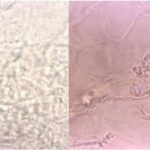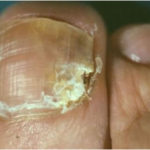Date: 26 November 2013
Copyright: n/a
Notes:
Dr Jenny Bartholomew is a Research Associate in the Institute of Inflammation and Repair, University of Manchester. A Manchester graduate – she formerly worked as a University Lecturer at Monash University, Melbourne for four years where she undertook research into the immunology of connective tissue damage and repair in rheumatoid arthritis, identifying TNF alpha in inflamed cartilage in an animal model of arthritis.
On returning to Manchester she moved to Christie Hospital, Manchester as a Research Fellow and University teacher where her main research interests were studying the immunological responses to human papillomavirus (HPV 16/18) in cervical cancer. Using recombinant vaccinia virus to express viral proteins from HPV, the major oncoproteins from HPV were studied and used in the development of the cervical cancer vaccine.
For the last 12 years she has been involved in Aspergillus research, providing clinical and scientific information to patients, doctors and scientists, she manages and publishes the Aspergillus website. This is a complex educational resource providing the latest research, technology and information for a wide diversity of users. She has a particular interest in video media and produces a broad range of video interviews from patients and clinics for educational use.
She is now engaged in global health programme. Jenny has launched the LIFE (Leading International Fungal Education) programme commencing with a public engagement and awareness project in 2012, combining Science with Art, aimed at educating young people about harmful fungi.
This was followed by the LIFE online resource (http://life-worldwide.org) for health care professionals encompassing all fungi, the infections they cause, diagnosis and treatments. This resource has a news flow about global health and is targeting global education about fungi and serious infections they can cause. The site is now being translated into Spanish and other languages will follow soon. She launched the Global Action Fund for Fungal Infection site (http://gaffi.org) in July 2013 – GAFFI is a foundation based in Geneva, focused on advocacy for access to diagnostics and treatment in every country.
Aspergillus website, Life worldwide organisation, GAFFI , National Aspergillosis Centre, Mycology Reference Laboratory and Fungal Infection Trust.
Some of my Publications:
- Bartholomew, J S, J M Evanson and DE Woolley . Rheumatol. Int., II: 37-40, 1991 Serum IgE Anti-cartilage Collagen Antibodies in Rheumatoid Patients.
- Bartholomew,J S,J M Evanson and DE Woolley . Allergy Digests, 2: 30-31, 1992 Collagen Specific IgE Antibodies in Rheumatoid Patients.
- Stacey,S N, J S Bartholomew, A Ghosh, P L Stern, M Mackett and J R Arrand. J.Gen. Vir., 73: 2337-2345, 1992 Expression of human papillomavirus type 16 E6 protein by recombinant baculovirus and use for detection of anti-E6 antibodies in human sera.
- Stacey,S N, A Ghosh, J S Bartholomew, R W Tindle, P L Stern, M Mackett and J R Arrand. J. Med. Virol., 40: 14-21, 1993. Expression of human papillomavirus type 16 E7 protein by recombinant baculovirus and use for the detection of E7 antibodies in sera from cervical carcinogen patients.
- Bartholomew,JS, S N Stacey, B Coles, D Burt, I R Arrand and P L Stern. European Journal of Immunology, 24: 3175-3179, 1994 Identification of a naturally processed HLA-A0201 restricted viral peptide from cells expressing human papillomavirus type 16 E6 oncoprotein.
- Bartholomew J and P L Stern.
In: Modulation of MHC Antigen Expression and Disease. Eds E G Blair, D J Maudsley and C P Pringle, 233-250, 1994 MHC expression in HPV associated cervical cancer. - Ellis JRM, P I Keating, J Baird, E F Hounsell, D V Renouf, M Rowe, D Hopkins, M F Duggan-Keen, J.S Bartholomew, L S Young and P L Stern. Nature Medicine, 1,464-470, 1995 An HP V 16 variant is associated with cervical carcinoma in HLA-B7 positive women.
- Bartholomew,JS, S. Glenville, S. Sarkar, D.I. Burt, M.A. Stanley, F. Ruiz-Cabens, J. Chengang, F. Garrido and P .L. Stern. Cancer Res. March 1, 1997. Integration of high-risk human papillomavirus DNA is linked to the down-regulation of Class I Human leukocyte antigens by steroid hormones in cervical tumour cells.
- Brady CS. Bartholomew JS. Burt DJ. Duggan-Keen MF. Glenville S. Telford N. Little AM. Davidson JA. Jimenez P. Ruiz-Cabello F. Garrido F. Stern PL.
Tissue Antigens. 55(5):401-11, 2000 May. Multiple mechanisms underlie HLA dysregulation in cervical cancer. - Fungi: friends or foes? Biological Sciences Review 17(1) 24-28, 2004
-
Mabey Gilsenan JE, Atherton G, Bartholomew J, Giles PF, Attwood TK, Denning DW, Bowyer P.
Aspergillus genomes and the aspergillus cloud Nucleic Acids Res. 2009 Jan;37(Database issue):D509-14. Epub 2008 Nov 27
E-mail: jennifer.bartholomew@manchester.ac.uk
Images library
-
Title
Legend
-
The chest X rays showed a rapid progression of lung disease- with bilateral upper zone and midzone consolidation and bilateral pleural effusion. Both lower lobes showed bronchiectasis in a central distribution along with centrilobular nodules and tree-in-bud pattern.
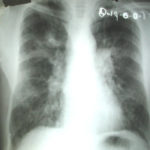 ,
, 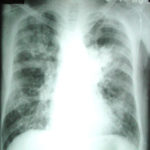 ,
, 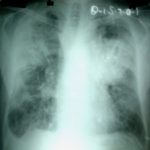 ,
, 
-
Patient EG Intraluminal aspergilloma in cystic fibrosis (12 months follow up)
The 21 year old woman with cystic fibrosis developed an aspergilloma in her left lower lobe bronchus. CF was diagnosed at 6 months of age (sweat chloride 78 and 100 mmol/L) and CFTR mutations δ508 and W1282X and she developed diabetes mellitus at age 12 years. Age 15 years ABPA was diagnosed. Her serum IgE at the time of diagnosis was 5060 IU/L, skin prick test for aspergillus was positive, and serum was positive for precipitating antibodies to Aspergillus. She was treated with oral prednisone (1 mg/kg/day) for first two weeks followed by prednisone at 0.5 mg/kg every other day for at least 6 months with some clinical and serologic improvement. Over the following 5 years, she presented with a pattern of repeated episodic exacerbations with wheezing and crackles, increases in IgE and need to increase prednisone dosage.
In the 12 months before the aspergillomas were found, she started to experience frequent pulmonary exacerbations, which have prompted intensive therapies. She has also been on oral prednisone & itraconazole for at least 9 months for her ABPA relapse with some clinical & serologic improvement. She then developed severe protracted coughing spells associated with minor hemoptysis, low grade intermittent fever, and weight loss. Her FEV1 declined in a 3 months period from 56% to 33%. A recent chest-x ray did not reveal any new changes when compared to the one obtained almost a year before. A CT scan of the chest, however shows an ovoid soft tissue density within an ectatic bronchi in the anterior basal segment of the lower left lobe, felt to be an aspergilloma. [Link here].
She was started on voriconazole 200 mg twice daily. This dose gave a random serum level of 5ug/L. Her prednisone was weaned to 5 mgs/day and her FEV1 increased to 46% of predicted. In January 2009, her IgE level was 3053 kU/L; one year later, her IgE level was 1167 kU/L. A lung transplant surgeon attempted unsuccessfully to remove the aspergilloma via flexible bronchoscopy. It took a while for her to recover from that procedure. She then had a pulmonary exacerbation. She tolerated voriconazole reasonably well and gaining some weight. By mid 2010, her IgE level was 637 IU/L.
In early 2011, her aspergilloma (yellow friable material) in the anterior segment of the left lower lobe was removed completely (Fig a and b). It took a little time, but with biopsy forceps and some mincing and homogenization, it was all sucked out. The 3D reconstruction (Fig c) only shows the area of bronchiectasis, not the aspergilloma.Dr. Turcios is the director of pediatric pulmonology/cystic fibrosis in Somerville, NJ.
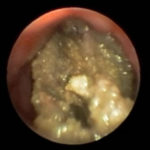 ,
, 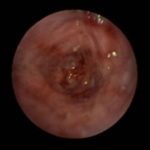 ,
, 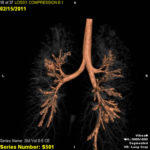
-
This patient is a 70 yr old, obese diabetic with aortic stenosis and COPD. He was admitted in early March 09, with collapse and loss of conciousness. His lungs appeared normal at this time – CT and X-ray 1. 10 days later he was admitted with increasing shortness of breath and chest X ray (F) showing widespread patchy consolidation. CT scan (B) showed bronchial dilatation, mucus plugging, nodular and bibasal consolidation. Multiple sputum samples grew Aspergillus fumigatus. The patient required intubation and remained in ITU for 160 days.
Bronchoscopy showed plaques in the major airways with more distal airways plugged with secretions resembling “cottage cheese”.There was severe contact bleeding and oedematous mucosa (I & J). Biopsy of the plaques showed fungal hyphae with a branching pattern consistent with aspergillus infection (G & H).
The patient was initially given IV and nebulised amphotericin B whilst on doses of hydrocortisone from 100-400 mg/day. Voriconazole was added with dose optimisation, and amphotericin discontinued. The patient improved gradually with voriconazole treatment over several months and for the latter month, gamma interferon was added into his regime which further improved his CT scan although some shadowing and bronchial wall thickening was still seen (D).
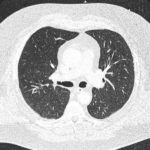 ,
, 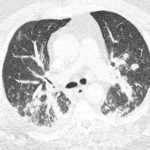 ,
, 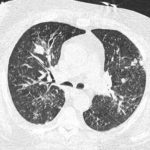 ,
,  ,
, 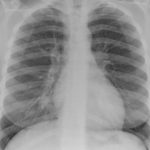 ,
, 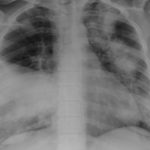 ,
,  ,
, 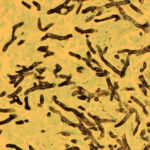 ,
,  ,
, 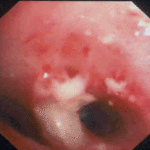
-
Hyphal septate club-like enlargements from culture on CYA 25°C medium (mag x100)
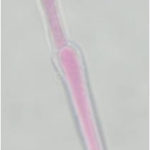
-
G Potassium hydroxide preparation of a nail specimen with onychomycosis- examined by microscopy
